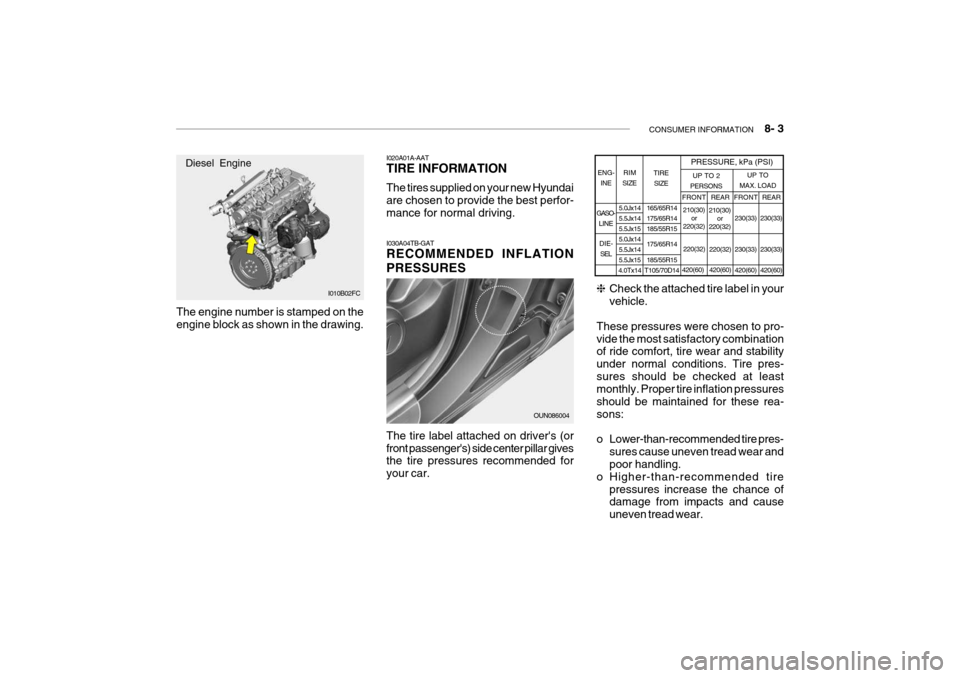2010 Hyundai Getz the engine
[x] Cancel search: the enginePage 234 of 256

DO-IT-YOURSELF MAINTENANCE 6- 37
G250C01TB-GAT FUSE PANEL DESCRIPTION Engine Compartment
PROTECTED COMPONENTS
Ignition Switch
Ignition Switch, Start Relay
Fuel pump, Alternator, ECMFFHS
Radiator FanHeadlight, Defogger RelayABSC/lighterAuto Fuel Cut Switch ABS ABS
Blower, Blower Motor
Power WindowElectronic power steeringECMECMA/CON, Fuel PumpInjectorA/ConditionerHornAlternator
FUSE RATING
30A30A30A30A30A50A10A25A15A10A20A40A30A30A50A10A20A10A15A10A10A
100A
DESCRIPTION
IGN 2IGN 1ECU
FFHS RAD
BATT ABS
C/LIGHTER F/PUMPECU-BABS1ABS2BLW
P/WDW EPS
ECU-1ECU-2 SNSR INJ
A/CON HORN BATT
NOTE: Not all fuse panel descriptions in this manual may be applicable to your vehicle. It is accurate at the time of printing. When you inspect the fuse box on your vehicle, refer to the fuse box label.
Diesel Engine
G200C01TB-2
Page 238 of 256

7- 2 EMISSION CONTROL SYSTEMS
H010A01A-GAT
EMISSION CONTROL SYSTEM (If Installed)
Your Hyundai is equipped with an
emission control system to meet all requirements of the Emission prohibi- tion rules of your province.
There are three emission control sys-
tems which are as follows.
1) Crankcase emission control sys-
tem
2) Evaporative emission control sys- tem
3) Exhaust emission control system
In order to assure the proper function
of the emission control systems, it is recommended that you have your carinspected and maintained by an au- thorized Hyundai dealer in accordance with the maintenance schedule in thismanual. H010B01A-AAT
1. Crankcase Emission Control
System
The positive crankcase ventilation
system is employed to prevent airpollution caused by blow-by gases being emitted from the crankcase. This system supplies fresh air to thecrankcase through the air intake hose. Inside the crankcase, the fresh air mixes with blow-by gases, which thenpass through the PCV valve and into the induction system.
H010C02E-GAT
2. Evaporative Emission Control
System
The Evaporative Emission Control
System is designed to prevent fuel vapors from escaping into the atmo-sphere. Canister
While the engine is inoperative, fuel
vapors generated inside the fuel tank are absorbed and stored in the canis- ter. When the engine is running, the fuel vapors absorbed in the canister are drawn into the induction system through the purge control solenoid valve. Purge Control Solenoid Valve (PCSV)
The purge control solenoid valve is
controlled by the Engine Control Mod- ule (ECM); when the engine coolanttemperature is low during idling, the PCSV closes so that evaporated fuel is not taken into the engine. After theengine warms-up during ordinary driv- ing, the PCSV opens so as to intro- duce evaporated fuel to the engine. H010D01A-AAT
3. Exhaust Emission Control
System
The exhaust emission control system is a highly effective system whichcontrols exhaust emission while main- taining good vehicle performance.
Page 239 of 256

EMISSION CONTROL SYSTEMS 7- 3
H020A01A-GAT
CATALYTIC CONVERTER (If Installed) ; For a gasoline engine
HTB5017
Hyundai vehicle is equipped with a monolith type three-way catalytic con- verter to reduce the carbon monoxide, hydrocarbons and nitrogen oxides con-tained in the exhaust gas. Exhaust gases passing through the catalytic converter may cause it to operate at avery high temperature. The introduc- tion of large amounts of unburned gaso- line into the exhaust may cause thecatalytic converter to overheat and create a fire hazard. This risk may be reduced by observing the following:
Catalytic Converter H020B03A-GAT
About the Catalytic Converter
Exhaust gases passing through the
catalytic converter cause it to operate at very high temperatures. As a re- sult, the introduction of large amountsof unburned gasoline may cause it to overheat and create a fire hazard. This can be avoided by observing thefollowing:
o Use unleaded fuel only.
o Maintain your engine in good con-
dition. Extremely high converter temperatures can result from im- proper operation of the electrical,ignition or fuel injection systems.
H020D01S-GAT CATALYTIC CONVERTER ; For a diesel engine Hyundai vehicle is equipped with oxi- dation type catalytic converter to re-duce the carbon monoxide, hydrocar- bons and particulate contained in the exhaust gas.
o If your engine stalls, pings, knocks,
or is hard to start, take your car toyour Hyundai dealer as soon aspossible and have the difficulty cor- rected.
o Avoid driving with a very low fuel level. If your run out of gasoline, it could cause the engine to misfireand result in excessive loading of the catalytic converter.
o Avoid idling the engine for periods longer than 10 minutes.
o Your Hyundai should not be either pushed or pulled to get it started.This can cause the catalytic con- verter to overload.
o Do not park, idle, or drive your vehicle over any combustible mate-rial such as grass, paper, leaves orrags. As these materials could come in contact with the catalytic con- verter and could cause a fire.
o Do not touch the catalytic converter
or any other part of the exhaustsystem while the engine is running as it is very hot and could result in burns.
o Remember that your Hyundai dealer is your best source of assistance.
Page 240 of 256

7- 4 EMISSION CONTROL SYSTEMS
H020C01S-GAT
EGR SYSTEM ; For a diesel engine
This system helps control oxides of nitrogen by recirculating a part of theexhaust gas into the engine.
Diesel Particulate Filter (If Installed) The Diesel Particulate Filter (DPF) system removes the soot emitted from the vehicle. Unlike a disposable air filter, the DPF system automatically burns (oxidizes) and removes the accumulated sootaccording to the driving condition. In other words, the active burning by engine control system and high ex-haust gas temperature caused by nor- mal/high driving condition burns and removes the accumulated soot.However, if the vehicle continues to bedriven at low speed for long time, theaccumulated soot may not be auto- matically removed because of low exhaust gas temperature. In this par-ticular case, the amount of soot is out of detection limit, the soot oxidation process by engine control system maynot happen and the malfunction indica- tor light may blink. When the malfunction indicator light blinks, it may stop blinking by driving the vehicle at more than 60km/h (37 mph) or at more than second gear with1500 ~ 2000 engine rpm for a certain time (for about 25 minutes). If the malfunction indicator light con-
tinues to be blinked in spite of the procedure, please visit an authorizedHYUNDAI dealer and then check the DPF system.
If you continue to drive with the mal-
function indicator light blinking for a long time, the DPF system can bedamaged and fuel consumption can be worsen.
Page 242 of 256

8- 2 CONSUMER INFORMATION
I030A01TB
I010A01TB-GAT VEHICLE IDENTIFICATION NUMBER (VIN)
The vehicle identification number (VIN) is the number used in registering your car and in all legal matters pertaining toits ownership, etc. It can be found on the center piller of the driver side and the lower side of thefront passenger seat. I010B01A-GAT ENGINE NUMBER
F040A01TB
F040A02TB
1.1L
1.4L/1.6L
I030B01TB
Page 243 of 256

CONSUMER INFORMATION 8- 3
The engine number is stamped on the engine block as shown in the drawing. I020A01A-AAT TIRE INFORMATION The tires supplied on your new Hyundai are chosen to provide the best perfor-mance for normal driving. I030A04TB-GAT RECOMMENDED INFLATION PRESSURES The tire label attached on driver's (or front passenger's) side center pillar gives the tire pressures recommended for your car. ❈
Check the attached tire label in yourvehicle.
These pressures were chosen to pro-vide the most satisfactory combination of ride comfort, tire wear and stability under normal conditions. Tire pres-sures should be checked at least monthly. Proper tire inflation pressures should be maintained for these rea-sons:
o Lower-than-recommended tire pres- sures cause uneven tread wear and poor handling.
o Higher-than-recommended tire pressures increase the chance ofdamage from impacts and cause uneven tread wear.
I010B02FC
OUN086004
Diesel Engine
5.0Jx14 5.5Jx14 5.5Jx15 5.0Jx145.5Jx145.5Jx15
4.0Tx14 TIRE
SIZE
RIM
SIZE PRESSURE, kPa (PSI)
165/65R14175/65R14 185/55R15 175/65R14 185/55R15
T105/70D14 REAR
220(32) 420(60) FRONT
230(33) 230(33) 420(60)
UP TO 2
PERSONS UP TO
MAX. LOAD
REAR
230(33) 230(33) 420(60)
FRONT
220(32)
420(60)
ENG- INE
GASO- LINE
DIE- SEL
210(30) or
220(32) 210(30)
or
220(32)
Page 250 of 256

9- 4 VEHICLE SPECIFICATIONS
Oil & Grease Standard
API service SAE 5W-20 (5W-30) SM* 1
or above, SAE 10W-30 (ABOVE -18°C)
ILSAC GF-4 SAE 15W-40 (ABOVE -13°C)
or above SAE 20W-50 (ABOVE -7°C)
API CH4 SAE 30 (0°C ~ 40°C)
or above, SAE 20W-40 (ABOVE -10°C)
ACEA B4 SAE 15W-40 (ABOVE -15°C)
or above SAE 10W-30 (-20°C ~ 40°C) SAE 5W-30 (-25°C ~ 40°C)SAE 0W-30 (BELOW 10°C) * 2
, * 3
* 2
. Restricted to driving condition and dealing area
* 3
. Not recommended for sustained high speed vehicle operation
Normal driving condition Severe driving condition HYUNDAI GENUINE PARTS MTF 75W/85 (API GL-4) HYUNDAI GENUINE ATF SP-III, DIAMOND ATF SP-III, SK ATF SP-III or other brands approved by Hyundai Motor Co.,PSF-3 DOT 3, DOT 4 or equivalent Ethylene glycol base for aluminum radiator
Item
Engine Oil Gaso- line Diesel
Recommends
Engine Oil Consumption Transaxle Manual Auto
Power Steering
Brake Fluid Coolant
J080A06TB-GAT LUBRICATION CHARTQuantity (liter) (Imp.qts.)
Drain and refill (with oil filter) 1.1L : 3.0 liter (2.6 Imp.qts.) 1.4L/1.6L : 3.3 liter (2.9 Imp.qts.) Drain and refill (with oil filter) : 5.3 liter (4.2 Imp.qts.) MAX. 1L / 1,500 Km MAX. 1L / 1,000 Km Gasoline : 2.15 liter (1.86 Imp.qts.) Diesel : 2.0 liter (1.75 Imp.qts.)6.1 liter (5.3 Imp.qts) (Gasoline only) As requiredAs required Gasoline : 5.5 liter (4.8 Imp.qts.) Diesel: 5.7 liter (5.0 Imp.qts.)
* 1
: If the API service SM engine oil is not available in your country, you are able to use API service SL.
J080A06TB-GAT LUBRICATION CHART
Page 252 of 256

10- 2 INDEX
A Active Headrests ........................................................ 1-18
Adjustable headrests .................................................. 1-17
Adjusting arm rest angle .............................................. 1-19
Air Bag ....................................................................... 1-38
Passenger's front airbag O N/OFF switch ................1-42
Side impact airbag ................................................... 1-43
Air Cleaner Filter ......................................................... 6-11
Air Conditioning Care ......................................................................... 6-18
Operation ................................................................. 1-95
Switch ...................................................................... 1-94
Antenna .................................................................... 1-130
Ashtray ....................................................................... 1-69
Audio remote control switch .......................................1-87
BBattery .............................................................. 2-17, 6-28
Before starting the engine ........................................... 2-3Brake Anti-lock system ...................................................... 2-13
Checking the brakes ................................................ 6-17
Fluid ......................................................................... 6-17
Pedal clearance ....................................................... 6-21
Pedal free play .......................................................... 6-21
Practices ................................................................. 2-12
Breaking-In your New Hyundai .................................... 1-4
Bulbs Replacem ent ..................................................... 6-30
Bulbs wa ttage ............................................................. 6-35C
Care of Cassette Tapes ...........................................
1-128
Care of Disc ............................................................. 1-128
Cargo area cover ........................................................ 1-82
Cassette Tape Player Operation (K220, K240, M280) ........................1-102, 1-107, 1-112
Catalytic Converter ...................................................... 7-3
Central Door Lock ....................................................... 1-10
Child-Protector Rear Door Lock .................................. 1-10
Child Restraint System ............................................... 1-30
Cigarette Lighter ......................................................... 1-68
Climate Control Air Filter .................................. 1-96, 6-19
Clock .......................................................................... 1-68
Clutch
Pedal freep lay .......................................................... 6-21
Combination Light
Headlight flasher ...................................................... 1-63
Headlight swi tch ...................................................... 1-61
High-beam switch .................................................... 1-62
Lane change si gnal .................................................. 1-61
Turn signal operation ............................................... 1-61
Compact Disc Player Operation
(M280, H446) .............................................. 1-115, 1-123
Console tray ............................................................... 1-70
Cooling Fans .............................................................. 6-26
Corrosion protection
Cleaning the interior .................................................. 4-5
Protecting your Hyundai from corrosion ................... 4-2
Washing and waxing ................................................. 4-3